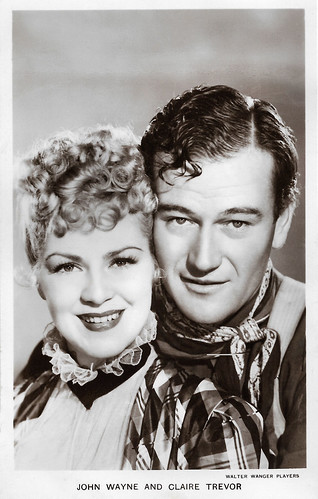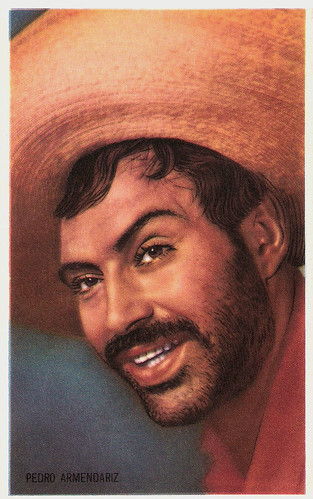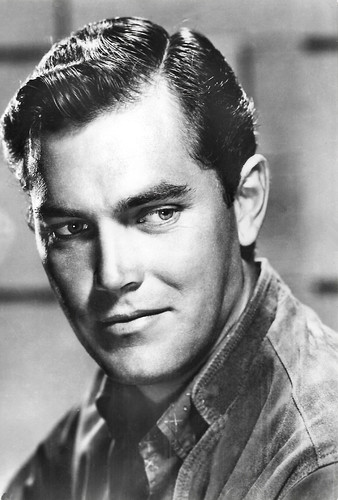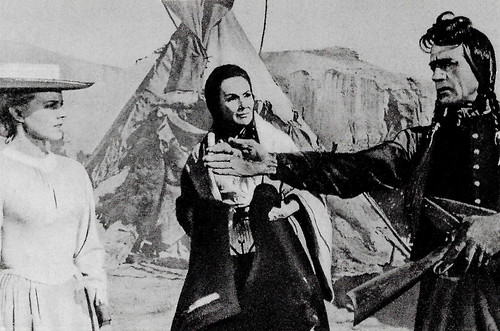
American postcard by Fotofolio, NY, NY, no. RA26. Photo: Richard Avedon. Caption: John Ford, Director, Bel Air, California, 4-11-72.

Spanish collector card in the 'Escenas selectas de cinematografia' series, series A, no. 12. Harry Carey in Three Mounted Men (John Ford, 1918). 'Cayena' refers to Carey's regular character Cheyenne Harry (Marked Men (1919), A Gun Fightin' Gentleman (1919), Ace of the Dalle (1919), etc.). The Spanish release title Lealtad (Loyalty) refers to this lost Western Three Mounted Men (1918).

Spanish postcard by Dümmatzen, no. 112. Photo: United Artists. Ronald Colman and Helen Hayes in Arrowsmith (John Ford, 1931).

British postcard in the Picturegoer Series, London, no. 797b. Photo: Walter Wanger. John Wayne in Stagecoach (John Ford, 1939).

French postcard by Humour à la Carte, Paris, no. 3400. Henry Fonda in The Grapes of Wrath (John Ford, 1940).
A large, long and difficult production
John Ford was born John Martin Feeney in 1894 in Cape Elizabeth, Maine, which is just south of Portland. His parents, John Augustine Feeney and Barbara Curran, were Irish immigrants who arrived in the United States in 1872. They had 11 children in all, six of whom lived to adulthood. John was their tenth child, born between a girl and a boy who both died as infants. A saloon keeper and an alderman, the Feeney family pater familias was a stereotypical Irish American, dabbling in both booze and politics in Portland, where John attended high school.
John Feeney followed his older brother Frank, who had renamed himself Francis Ford, to Hollywood. Frank, who was 13 years John's senior, had started as a film actor in 1909 and eventually appeared in about 500 films. He also established himself as a film director, helming almost 200 films beginning in 1912, when he shot Western shorts for Thomas H. Ince at Bison Motion Pictures. Ford started in his brother's films as an assistant, handyman, and stuntman. Francis gave his younger brother his first acting role in The Mysterious Rose (1914).
Renaming himself Jack Ford, John Feeney acted in 15 of his brother's pictures from 1914 through 1916. He also appeared as a member of the Ku Klux Klan in D.W. Griffith's The Birth of a Nation (1915), the American cinema's first certifiable blockbuster. The film was banned in Boston to forestall the possibility of its inciting racial violence and is still controversial. Young Jack Ford began to exit his brother's orbit and establish himself on his own when he moved from Bison to Universal as a director. It was by directing films from behind the camera instead of acting in them before the camera that he made his reputation.
Ford's first feature-length production was Straight Shooting (1917) with Harry Carey, which is also his earliest complete surviving film as director. He was extraordinarily productive in his first few years as a director — he made ten films in 1917, eight in 1918 and fifteen in 1919. When his Western Hell Bent (1918) for Universal was released, Motion Picture News praised Ford's direction, writing, "Few directors put such sustained punch in their pictures as does this Mr. Ford." It was the ninth in a series of films featuring Harry Carey as Cheyenne Harry. Carey was the star of 25 Ford silent films. His feature Cameo Kirby (1923), starring screen idol John Gilbert - another of the few surviving Ford silents - marked his first directing credit under the name 'John Ford'.
A year later, he directed his first masterpiece, the Western The Iron Horse (1924), an epic account of the building of the First transcontinental railroad. It was a large, long and difficult production, filmed on location in the Sierra Nevada. The logistics were enormous—two entire towns were constructed, there were 5000 extras, 100 cooks, 2000 rail layers, a cavalry regiment, 800 Native Americans, 1300 bison, 2000 horses, 10,000 cattle and 50,000 properties, including the original stagecoach used by Horace Greeley, Wild Bill Hickok's derringer pistol and replicas of the 'Jupiter' and '119' locomotives that met at Promontory Summit when the two ends of the line were joined in 1869. The Iron Horse became one of the top-grossing films of the decade, taking over US$2 million worldwide, against a budget of $280,000. Ford made a wide range of films in this period, and he became well known for his Western and 'frontier' pictures, but the genre rapidly lost its appeal for major studios in the late 1920s. Ford's last silent Western was 3 Bad Men (1926). Only ten of the more than sixty silent films John Ford made between 1917 and 1928 still survive in their entirety.

British postcard. Photo: Columbia. Jean Arthur in The Whole Town’s Talking (John Ford, 1935). Collection: Marlene Pilaete. Passport to Fame was the British premiere title.

British Real Photograph postcard, London, no. FS 121. Photo: Samuel Goldwyn. Jon Hall and Dorothy Lamour for The Hurricane (John Ford, 1937).

British Real Photograph postcard, London, no. FS 108. Photo: 20th Century Fox Film. Shirley Temple, Victor McLaglen and Douglas Scott in Wee Willie Winkie (John Ford, 1937).

British postcard in the Picturegoer Series, London, no. FS 163. Photo: 20th Century Fox. Richard Greene and Loretta Young in Four Men and a Prayer (John Ford, 1938).

British postcard in the Film Partners Series, London, no. P 289. Photo: Walter Wanger. John Wayne and Claire Trevor in Stagecoach (John Ford, 1939).
Exploding industry prejudices by becoming both a critical and commercial hit
John Ford was one of the pioneer directors of sound films. He shot Fox's first song sung on screen, for his film Mother Machree (1928). In the 1930s, Ford began to create the body of work that established his greatness while working for production chief Darryl F. Zanuck at 20th Century Fox. Ford worked with the studio's two superstars, Shirley Temple and Will Rogers, the #1 and #2 draws at the box office. He won his first Oscar for R.K.O.'s The Informer (1935). The film also earned an Academy Award nomination for Best Picture and garnered a Best Actor Oscar for long-time Ford collaborator Victor McLaglen. Ford was a master of many genres, and even directed comedies such as Will Rogers's Steamboat Round the Bend (1935).
The politically charged The Prisoner of Shark Island (1936) — which marked the debut with Ford of long-serving 'Stock Company' player John Carradine — explored the little-known story of Samuel Mudd, a physician who was caught up in the Abraham Lincoln assassination conspiracy and consigned to an offshore prison for treating the injured John Wilkes Booth. He directed the South Seas melodrama The Hurricane (1937) and the lighthearted Shirley Temple vehicle Wee Willie Winkie (1937), each of which had a first-year US gross of more than $1 million.
John Ford directed contemporary dramas and historical epics, but strangely, he stayed away from the Western, except for Stagecoach (1939). The genre had fallen out of favour with the big studios during the 1930s and Westerns were regarded as B-grade 'pulp' movies at best. As a result, Ford shopped the project around Hollywood for almost a year. Stagecoach exploded industry prejudices by becoming both a critical and commercial hit, grossing over US$1 million in its first year (against a budget of just under $400,000), and its success helped to revitalise the moribund genre, showing that Westerns could be "intelligent, artful, great entertainment—and profitable". Stagecoach was nominated for seven Academy Awards, including Best Picture and Best Director, and won two Oscars, for Best Supporting Actor (Thomas Mitchell) and Best Score. The classic created the cliché of the drunken doctor (Thomas Mitchell) in an action film.
In the 1940s, Ford won back-to-back Best Director Oscars for The Grapes of Wrath (1941), the screen adaptation of John Steinbeck's Pulitzer Prize-winning novel and How Green Was My Valley (1942), based on Richard Llewellyn's memoir of his youth in the coal-mining region of Wales. Ford had sat out the First World War, the War to End All Wars, but in the 1930s, John Ford had joined the U.S. Naval Reserve as the country once again moved towards participation in a European war that seemed inevitable with the rise of Hitler in Germany. When the U.S. entered World War II after the Japanese attack on Pearl Harbor, Ford went on active duty and headed a documentary film unit. For his Navy documentaries, he won back-to-back Academy Awards for The Battle of Midway (1942) in 1943 and for December 7th (1943) in 1944. Thus, from 1941 through 1944, John Ford won an Oscar each year for directing two feature films and two documentaries, a feat which remains unprecedented.
In the mid-1940s, John Ford began to focus on Westerns again, beginning with My Darling Clementine (1946) starring Linda Darnell and Henry Fonda, one of the classics of the genre. In his Westerns, he made frequent use of location shooting and wide shots, in which his characters were framed against a vast, harsh, and rugged natural terrain. Many of his Westerns featured John Wayne, whom he had first worked with on Stagecoach (1939) and who became a superstar in Howard Hawks' classic oater Red River (1948) opposite Montgomery Clift. For Ford, Wayne appeared in Fort Apache (1948), She Wore a Yellow Ribbon (1949) and Rio Grande (1950), the famous 'Cavalry Trilogy.'

Belgian collectors card. Photo: Argosy / M.G.M. John Wayne in 3 Godfathers (John Ford, 1948).

Mexican collector card. Photo: Pedro Armendáriz in 3 Godfathers (John Ford, 1948).

Spanish postcard by Ediciones Raker, Barcelona, no. 129. Photo: Warner Bros. Jeffrey Hunter in Sergeant Rutledge (John Ford, 1960).

East-German postcard by VEB Progress Film-Vertrieb, Berlin, no. 3143, 1968. Retail price: 0,20 M. Photo: Carroll Baker in Cheyenne Autumn (John Ford, 1964).

East-German collector card in the 'Neu im Kino' series by VEB Progress Film-Vertrieb, Berlin, no. 500/6/68. Carroll Baker, Dolores del Río and Ricardo Montalban in Cheyenne Autumn (John Ford, 1964).
The perfect correlative for Hollywood myth-making
John Ford directed sixteen features and several documentaries in the decade between 1946 and 1956. As with his pre-war career, his films alternated between (relative) box office flops and major successes, but most of his later films made a solid profit. In 1953, Ford won his sixth Best Director Oscar for his paean to the Ireland of his parents, The Quiet Man (1952), starring John Wayne and Maureen O'Hara.
It's notable that from 1950 through 1959, Ford made only one Western, the classic The Searchers (1956), one of the greatest examples of the genre. Starting with The Horse Soldiers (1959) which he made for the Mirisch Co. at the end of the decade, six of his last eight completed films were Westerns. His final great Western was The Man Who Shot Liberty Valance (1962) starring James Stewart and John Wayne.
Jon Hopwood at IMDb: "Ford was plumbing the nature of American myth-making, and the creation of history as a historical narrative, that is, the re-creation of history, after the fact, i.e., history as something man-made, thus fallible. He had found the perfect correlative for Hollywood myth-making." The Man Who Shot Liberty Valance (1962) took on these issues with a literalness that caused many contemporary critics to dismiss the film. Donovan's Reef (1963) was Ford's last film with John Wayne. Filmed on location on the Hawaiian island of Kauai, it was a morality play disguised as an action-comedy, which subtly but sharply engaged with issues of racial bigotry, corporate connivance, greed and American beliefs of societal superiority. The supporting cast included Lee Marvin, Elizabeth Allen, Jack Warden, Dorothy Lamour, and Cesar Romero. It was also Ford's last commercial success, grossing $3.3 million against a budget of $2.6 million.
Cheyenne Autumn (1964) was Ford's epic farewell to the West, which he publicly declared to be an elegy to the Native Americans. It was his last Western, his longest film and the most expensive movie of his career ($4.2 million), but it failed to recoup its costs at the box office and lost about $1 million on its first release. Ford's last completed feature film was 7 Women (1966), a drama set in about 1935, about missionary women in China trying to protect themselves from the advances of a barbaric Mongolian warlord. Anne Bancroft took over the lead role from Patricia Neal, who suffered a near-fatal stroke two days into the shooting.
Ford's health deteriorated rapidly in the early 1970s; he suffered a broken hip in 1970 which put him in a wheelchair. As befitted his status as America's premier director, in 1973, John Ford was the recipient of the first Lifetime Achievement Award from the American Film Institute. President Richard Nixon presented Ford with the Presidential Medal of Freedom, the highest civilian award in the U.S. Ford died in 1973, at Palm Desert and was interred in Holy Cross Cemetery in Culver City, California. John Ford had one wife, Mary Ford-McBride Smith, a son, Patrick Ford, and a daughter, Barbara Ford. His grandson, Dan Ford wrote a biography on his famous grandfather.

British poster postcard by Pyramid, London, no. PC 8499. Photo: United Artists. John Wayne in the classic Western Stagecoach (John Ford, 1939).

French poster postcard by Edition F. Nugeron, no. E 64. Photo: Belga Films. Belgian poster for the classic Western She Wore a Yellow Ribbon (John Ford, 1949) with John Wayne.

Italian collector card by G.B. Pezziol, Padova / Stab. Pezzini, Milano. Photo: Republic Pictures. John Wayne and Maureen O'Hara in The Quiet Man (John Ford, 1952), released in Italy as Un uomo tranquillo.
Sources: Jon Hopwood (IMDb), Wikipedia and IMDb.
I never fail to watch THE QUIET MAN every St. Patrick's Day here. Ford was simply marvelous and had a touch for light comedy as well as just about every genre.
ReplyDelete